The common conception of medieval tournaments typically mirrors the depiction of tournaments in movies, games and fantasy literature: two knights charging each other,
until one unhorses his opponent, proceeding to the next round, sometimes duels may follow. This is done until a some winner emerges. As rewards, winners get monetary prizes, the recognition of their peers and lords, or the favor of a lady.
The knights are usually depicted wearing more or less the same armor they would wear in battle, but overall lack in visual interest. There is some shouting, trumpets, and yada yada.
In reality medieval tournaments were much more dynamic, impressive, and grandiose. The pop-cultural depiction is somewhat influenced by early-modern tournaments (which were somewhat distinct from medieval ones), and
the all-so infamous Victorian romanticizing - or the opposite of that - thereof.
What, then, were medieval tournaments actually about
While something akin to tournaments already exited in Roman antiquity, usually when people are talking about tournaments in a historical context they refer to medieval or early-modern tournaments.
And while there are records of cavalry competitions, whether as display of equestrian skills (“tournament” comes from the French word for turning - turning your horse in tight spaces was difficult and a sign of good horsemanship) or forms of fighting on horseback from the early middle-ages, historians usually agree that medieval tournaments
started somewhere in the 12th century.
During this time knights began to meet for mock battles, where they would arrive with their full equipment, organizing into teams or groups and fight - or at least started to record these events around that time. These early mock battles were usually carried out on a field wherever they saw convenient with only a few spectators.
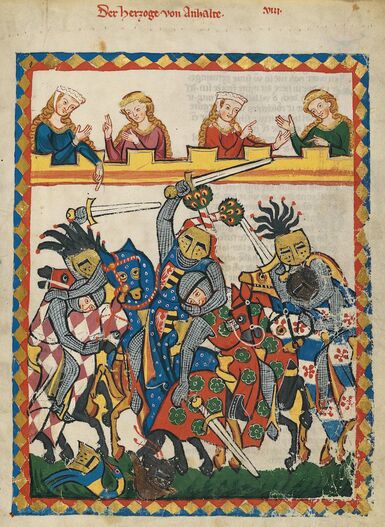
And here lies the main purpose of these early tournaments: training for war. They formed groups and fought in formation because this is what they would do in battles. They would take each other as prisoners because that’s what they would do in battle (and because it brought them money - these tournaments could be quite lucrative). They tried to skillfully unhorse or outmaneuver their opponent. They usually didn’t charge at each other in straight lines in one-on-one duels because this would rarely happen in real combat, though occasional exceptions existed - at least if we believe epic retellings of battles.
These battles were an opportunity to test which tactics worked, as well as a chance to form bonds and alliances with fellow knights by fighting together, gaining the respect of their peers by proving oneself
in combat, even if the combat wasn’t entirely ‘real’. (injuries of all degrees were fairly common, as was the occasional death).
Since these battles sometimes took place where peasants worked and lived they started to complain about these knights meeting to fight on their domains. Especially the clergy viewed
those tournaments as needlessly brutal and vain at the expense of the everyday life of the locals. But despite them repeatedly admonishing participants and telling the nobility to stop these tournaments continued. Ironically, even some people from the higher-ranking clergy participated in these tournaments on occasion.
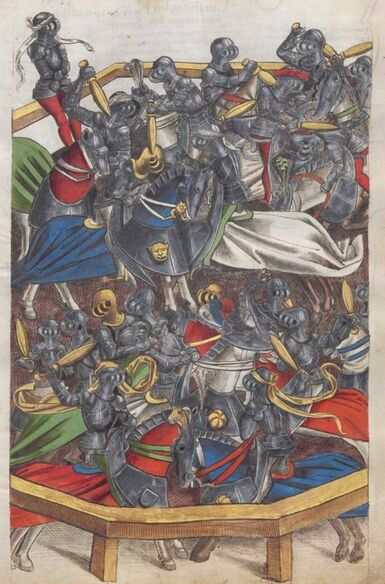
These fights started to evolve over time - there are some indications that there might have been “safe-zones” where you could catch your breath, or ladies or heralds could provide a pause for a knight of their choosing during the battle. These battles varied from place to place - especially the German speaking regions had the so-called Kolbenturnier, a club-tournament where they would use wooden clubs.
Knights started to form societies which organized these tournaments, some of these societies could become quite powerful and influential. In the late middle-ages higher nobility would replace the role of these societies though.
Over time these tournaments changed into something more formalized, attracting more spectators, new rules and a system to follow. While the meelee, the mock-battle, remained the focal point, the most important part of the tournament, jousting and duels soon were added. Spectators, especially the higher nobility, offered an opportunity for social advancement. If you could prove yourself to be a capable knight in battle you could gain the favor of some other, more important nobleman, perhaps even the king, who might then employ you.
But spectators also meant that you had to put in more effort in representing yourself and your house. Knights bought, and sometimes went into debt for, new sets of armor made only for tournaments, adorned themselves and their horses with expensive cloth, added fancier crests (they also used those in real battles, but went for more expensive and elaborate ones in tournaments) on-top of their helmets and much more. Serving as the page for a knight who gained lots of renown in a tournament might even make you famous. In short: tournaments became a way of representing yourself in front of a crowd of nobility; something that could reshape your political career completely.
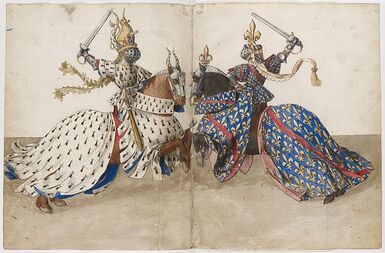
Displaying wealth was just as important as exhibiting proper courtly manners, horsemanship, physical prowess and combat skill;. And here is something that might seem odd for modern athletes but generally held true: winning wasn’t necessarily that important. Participating and fighting was, self-representation was. But winning? If you get surrounded in a meelee by multiple opponents, manage to deftly gain advantage and defeat some of them but eventually get overwhelmed you might not have won, but you displayed great skill and could impress important people, which then could improve your social or political standing over the course of only a few days or weeks.
Storytelling, recreating old battles, retelling ancient mythology also became an integral part of medieval and early-modern tournaments. Dressing up, one might call it cosplaying, or having your pages in costumes was also a thing. Pretending to fight your way to a “damsel in distress”, having to fight for a key to the tower she was trapped in, pretending to be some ancient Greek hero - all of these things were part of many tournaments. Does this remind you of the spectacles and fights in the Colosseum or other Roman amphitheaters? Whether the medieval people were inspired by the Romans, we don’t know. But it is entirely plausible that something similar developed independently, and humans like turning sport into pompous events - just look at the Olympic games, football world-cup or the American Superbowl!
Therefore, tournaments could also be used to improve morale, for local organizers or patrons to gain popularity among the people. During the Siege of Neuss in 1474 the defenders organized a tournament inside the besieged city. On one hand this was to entertain the citizens inside, on the other hand this was to show the attackers that the people inside the walls weren’t done any time soon. Tournaments were held before or after coronations, after victory in a a war or any other kind of celebration. They were used by lords to gather their knights in one place and have them renew their oath of fealty, gather support for some policy or (possibly political) conflict and much more. In short: tournaments soon also became a political tool, a form of celebration and a show of force/power.
Citizens started to become involved
As tournaments gained a broader appeal, wealthy individuals of the rising citizen class, especially in the Holy Roman Empire, in the late-middle ages also wanted to participate in these events. Knights weren’t too keen in letting plebs participate in their spectacles, so some tournaments, or certain parts of the tournaments, required proof that your were a descendant of a noble line (usually 2 generations). But despite the attempts to stop plebs from participating, the crests and insignia of wealthy citizen-families became increasingly common in jousts - the meelee was usually still knights-only as it was considered the “higher” and more important part of the tournament. But something odd started to happen: the citizens started to become really good at jousting.
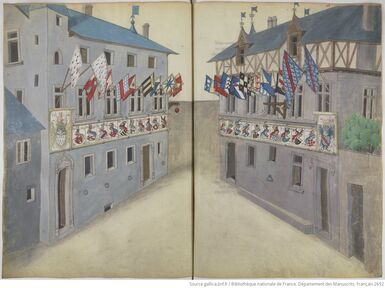
Knights, as part of the ruling class didn’t necessarily have the same amount of time as some citizens for practicing jousting. They had to train for battle, for war in which they then would also participate in, fight in feuds, rule over their lands which meant administrative work, socialize and build a network of allies for which they often had to travel around, study, and so on. Jousting itself was therefore not always a priority. Some wealthy citizens often had more time to spare for practice than large parts of nobility.
Tournaments in the early-modern period
The meelee would become less relevant over time while the joust started to be the spectacle. Armor specifically made for tournaments (not just from an aesthetic point-of-view, also from a technical one), with lance rests (or arrêt) to direct the force of the impact into the entire armor of the wearer for stronger blows, armor to protect against breaking your neck when falling from the horse by limiting the movement of the neck and detaching your head from the armor (like being inside a shell that doesn’t touch you), frog-mouth helmets in which you were essentially blind once you straightened your back, less mobility and thicker plates, etc… armor that you wouldn’t want to use in battle but were nearly perfect for preventing injuries and mobile enough to get on a horse and steer it straight forward.
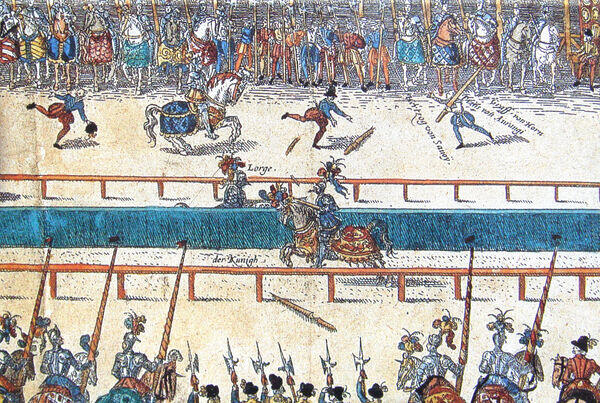
Shields, often targes,
with spring mechanisms such that the shield would either fly away or burst on a good hit, lance points which didn’t’ have one point but rather three points to distribute the force better and help catching
the enemy helmet, shield or some other piece of armor to rip it (partly) off. All of the medieval and early-modern love for complex mechanisms poured into equipment for tournaments.
Eventually tournaments started to disappear together with the knight, or at least the identity of the medieval knight, in the late 16th-17th century.
Some closing thoughts
There is much more to write about; armor and heraldry during tournaments, how tournaments were organized, the actually procedure, how it changed over time, differences between the various regions, and much, much more. There are lots of historical examples, pictorial and textual sources so we do have a fairly decent idea how those tournaments worked. But that would make this article a bit too long
If you want to look at some historical depictions or a tournament I can recommend the King René’s Tournament Book or Das Hausbuch der Herren von Hallwil)
I hope I could give a general idea about tournaments, and more importantly why these tournaments were actually a thing and how their purpose changed over time.